American corporate giant HP – yes, the same HP that makes 2D printers, laptops, and ground-breaking polymer 3D printers – just unveiled a new and improved version of its metal 3D printer called Metal Jet S100 aimed at industrial-scale metal part production.
The company debuted the Metal Jet technology in 2018 and had some high-profile applications (Volkswagen, Cobra Golf) but did not release the machine commercially. Instead, it has worked closely with select companies in various industries on beta testing new features and processes before rolling out the new version, the S100, at the International Manufacturing Technology Show in Chicago last week.
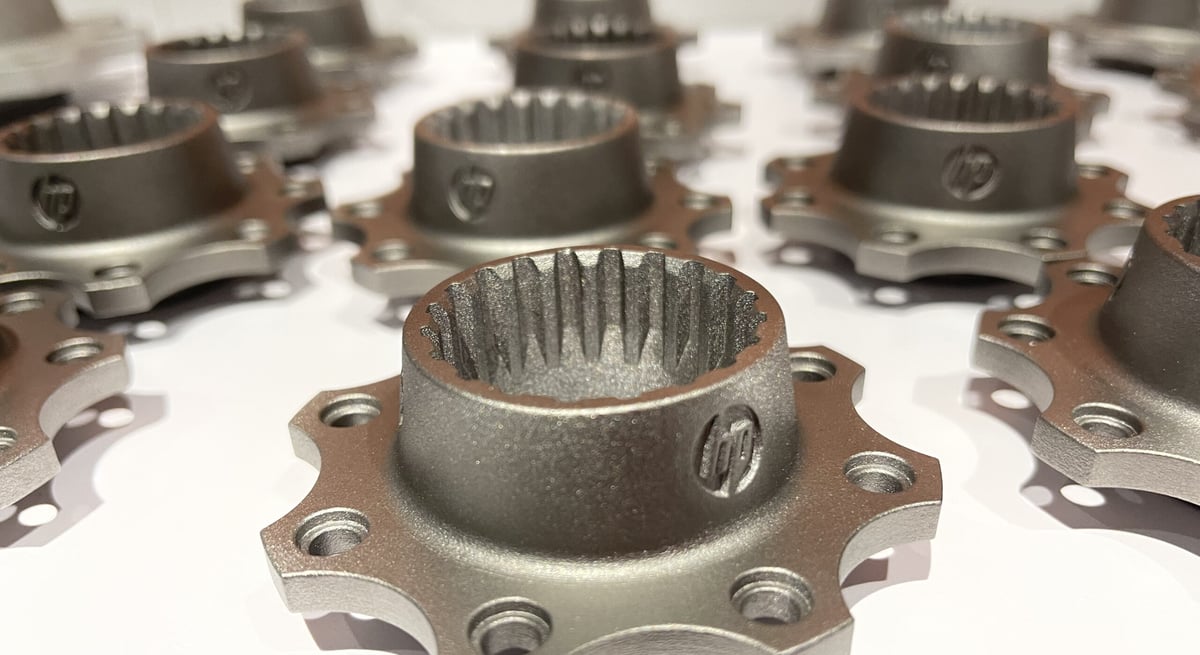
The Windy City event for manufacturers was the ideal venue to debut the S100, the company says, because the target application is industrial-scale serial production of complex metal parts. The S100 is part of what HP calls its Metal Jet System, which includes all the machines and software a manufacturer would need to produce metal parts in the thousands or tens of thousands.
“HP Metal Jet represents the first truly viable 3D technology for the industrial-scale production of metal parts,” says Rob Hall, President of Parmatech, a California-based contract manufacturing company with expertise in metal injection molding and metal 3D printing. As a participant in the HP development program for the S100, Parmatech partnered with HP and Cobra Golf to manufacture and launch a 3D printed putter in 2020.
Parmatech says the technology enables them to create metal part prototypes for customers in a day or two instead of the weeks or months it would take with injection molding at a fraction of the cost. Parmatech then scales with the same technology up to 10,000 parts.
“Our threshold with injection molding is 10,000 to 12,000 parts per year,” says Hall. “Anything below that doesn’t make economic sense because the upfront costs are too great.” HP Metal Jet enables Parmatech to offer its customers a more affordable opportunity for medium volume and unique part production, the company says.
HP, Already Dominating in Production Polymer 3D Printing
There’s no denying that after six years and more than 100 million 3D printed parts, HP dominates in the polymer 3D printing arena. Its Multi Jet Fusion (MJF) technology is used for series production and custom parts by Toyota, Ford, L’Oréal, and SmileDirectClub among others. Multi Jet Fusion 3D printers are standard equipment among the world’s busiest on-demand additive manufacturers.
In the second quarter of 2022, HP’s revenue rose 3.9% due in part to the strong performance of its 3D printing division, the company says. Whether polymer or metal, HP has always focused on volume production and nailing all the processes that make it efficient, cost-effective, fast, and sustainable.
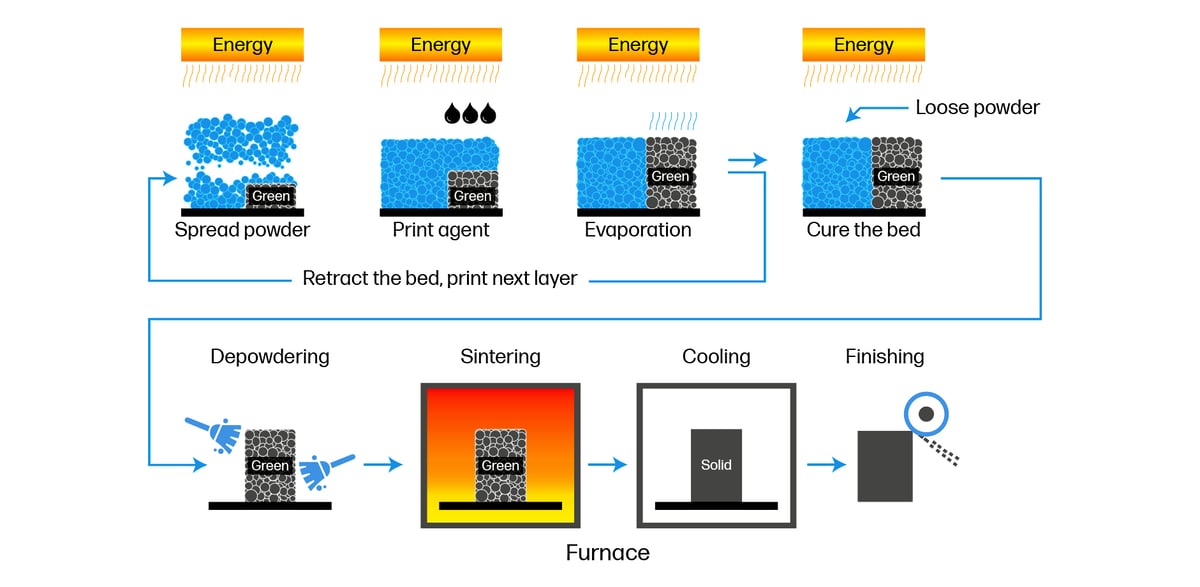
What is the HP S100?
The HP S100 metal 3D printer uses binder jet technology, which is a method of 3D printing that uses a liquid binding agent deposited in tiny drops on powdered materials in layers to create solid, complex shapes. As the build progresses, the print layers are bonded together, resulting in a powder box with the desired part geometry inside.
The process is similar (but not identical) to HP’s MJF but only use metal powder, specifically stainless steel (316L and 17-4PH).
Binder jetting has several advantages over traditional metal injection molding and other forms of metal 3D printing, depending on your requirements. The technology especially shines regarding speed and resolution since printheads typically work faster than lasers or electron beams. There’s also a far lower material cost with binder jetting because it uses the same commonly available metal powder as injection molding.
Some of the advantage binder jetting may have in printing speed could be lost in the multi-step post-processing phase, but that depends on the application. Dozens of parts can be printed at once, which typically works to binder jetting’s favor. Plus, the need for support structures is eliminated or significantly reduced for any part geometry produced by binder jetting because the powder bed provides enough support, which means greater design freedom (especially to create internal channels), less material waste, and less time and labor to remove supports, and more space to nest many parts in one build volume.
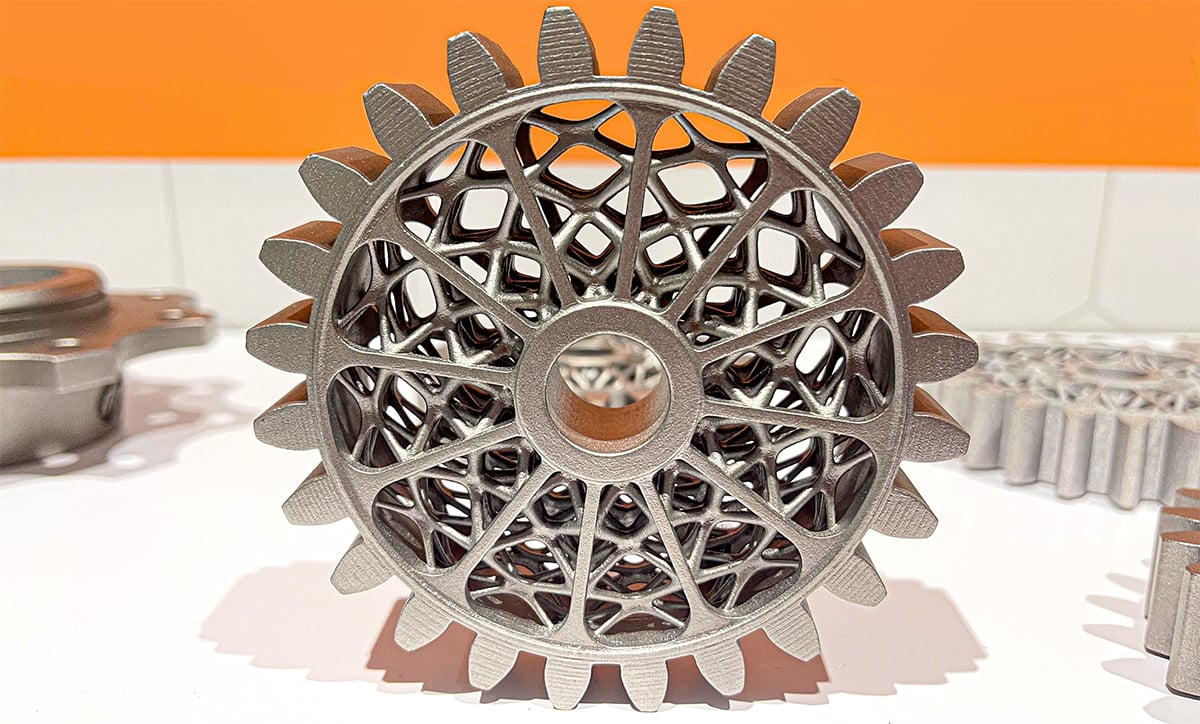
Overall, the material properties of metal binder jet parts are equivalent to (or better than) metal parts produced with metal injection molding, which is one of the most widely used manufacturing methods for the mass production of metal parts. Plus, binder jet parts exhibit higher surface smoothness, especially in internal channels. 3D printing enables complex structures, unseen internal features, and lattice designs often used to make parts and products weigh less, fit tight spaces, and perform more efficiently (as is the case with 3D printed heat exchangers).
HP Metal Jet not only leverages these advantages of metal binder jetting over other metal 3D printing, but it has years of expertise in workflows, processes, and technologies developed for plastic 3D printing.
HP says the breakthroughs in quality and speed it developed in the Metal Jet beta testing will accelerate the adoption of metal 3D printing, in general, to create “a digital transformation of manufacturing as widespread and profound as the way HP Thermal Inkjet changed the landscape of conventional printing markets and applications.” A game changer for metal 3D printing if it turns out to be true.
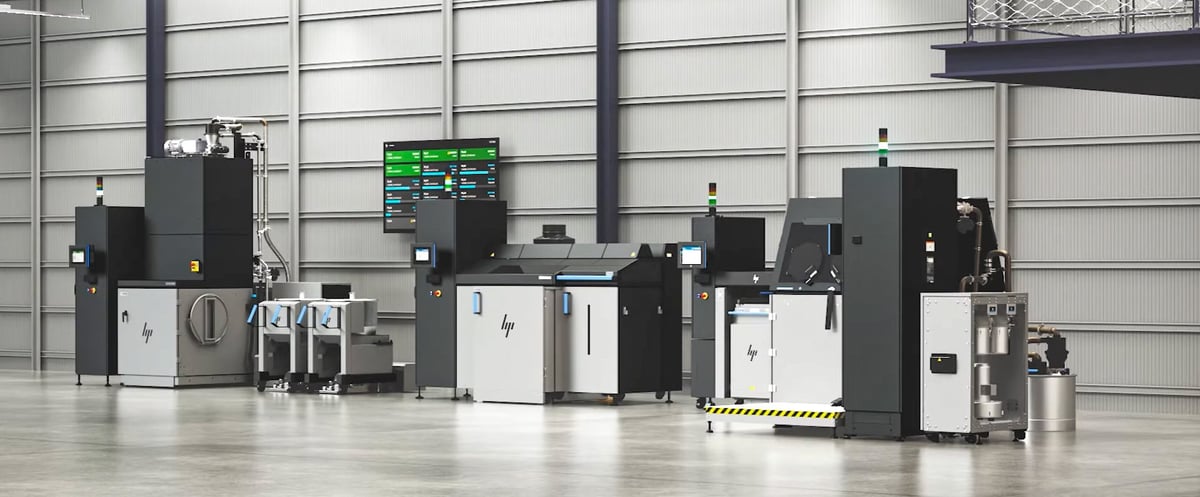
The Right Metal Printing Solution at the Right Time?
Although the most common type of metal 3D printing today is selective laser melting, some of the biggest names in metal 3D printing are betting on binder jetting. GE, for example, has a line of metal binder jet machines still in beta testing with select consumers — like HP was until very recently. US-based Desktop Metal, which also makes metal binder jetting machines, acquired its closest competitor ExOne in 2021, which left only one other metal binder jetting contender on the market, Digital Metal, which was just acquired by Markforged in 2022.
HP’s timing may position it ahead of the competition in this shake-up of the metal binder jet market with a product it says is perfected after four years of beta testing and based on 80 years of machine-making expertise.
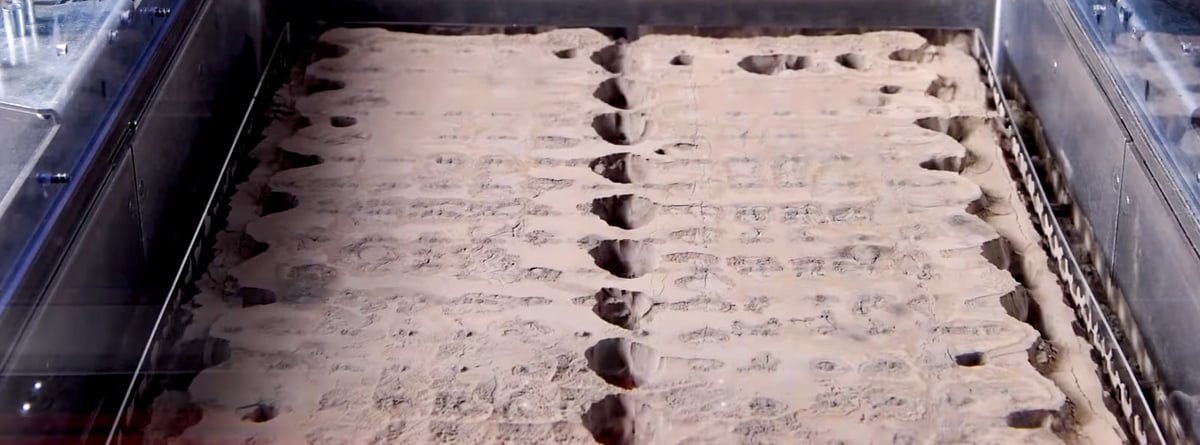
HP S100 Tech Specs
Now let’s take a look at the platform itself, which is an integrated multi-machine system with software. Small production volumes can be achieved with one printer, but multiple printers are ideal because they are designed to be networked and controlled with the company’s software.
The end-to-end modular approach enables parts to travel between four stations — powder, print, cure, depowder — for continuous production in a detachable build unit so there’s no mess of handling loose metal powder and may also cut down on labor.
HP seems to have taken the typical metal powder bed printing hazards out of the equation with its integrated platform, but it does appear to require investing in seven or eight pieces of equipment. A powder management station mixes and sieves the powder (much of which can be reused from previous prints) and fills the build unit, which then goes to the 3D printer. After printing, the build unit goes to the curing station and then to the powder removal station. At this point, the part is ready to be sintered in any industry standard sintering furnace after which it can be machined or finished if necessary.
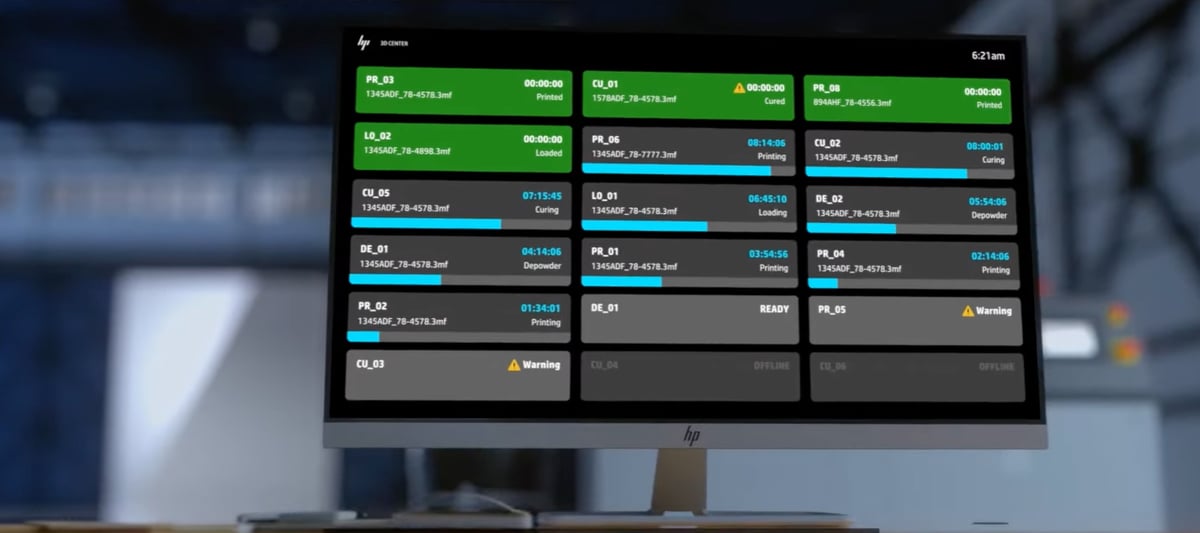
HP Metal Jet S100 printer itself has a decent build volume (430 x 309 x 200 mm) to accommodate multiple parts or large parts. It has a fine layer height of 35 to 140 microns resulting in a smooth surface.
While the metal powder is industry standard, the binding agent is proprietary. The S100’s inkjets can precisely place up to 630 million nanogram-sized drops per second of liquid binding agent onto a powder bed to define a part’s cross-section layer by layer. The binding agent is formulated with a polymer that binds the metal particles together. Curing the bed evaporates liquid components. After curing and depowdering, parts are placed in a furnace where the polymer decomposes resulting in a 96% dense metal part with isotropic properties that meet ASTM and MPIF standards, HP says.
Binder jetting can produce various metal densities with controlled porosity based on the sintering temperature and time, which leads to a wide range of applications.
How much will these machines set you back? Well, it is a turn-key full metal factory — HP hasn’t left out one essential accessory. However, they’re not putting a price tag on the full modular system, opting instead to say that each direct engagement with HP for Metal Jet is a custom engagement. Every customer may need different elements of the solution in different quantities to scale, HP says.
HP Metal Jet S100 3D Printing Solution
- Technology: Binder jetting
- Build volume: 430 x 309 x 200 mm
- Min. layer height: 35 microns
- Materials: Stainless steel (316L, 17-4PH)
- Software: HP Metal Jet Command Center, HP Metal Jet API, HP Metal Jet Process Development Suite
- Price: Customized
- Availability: 2023
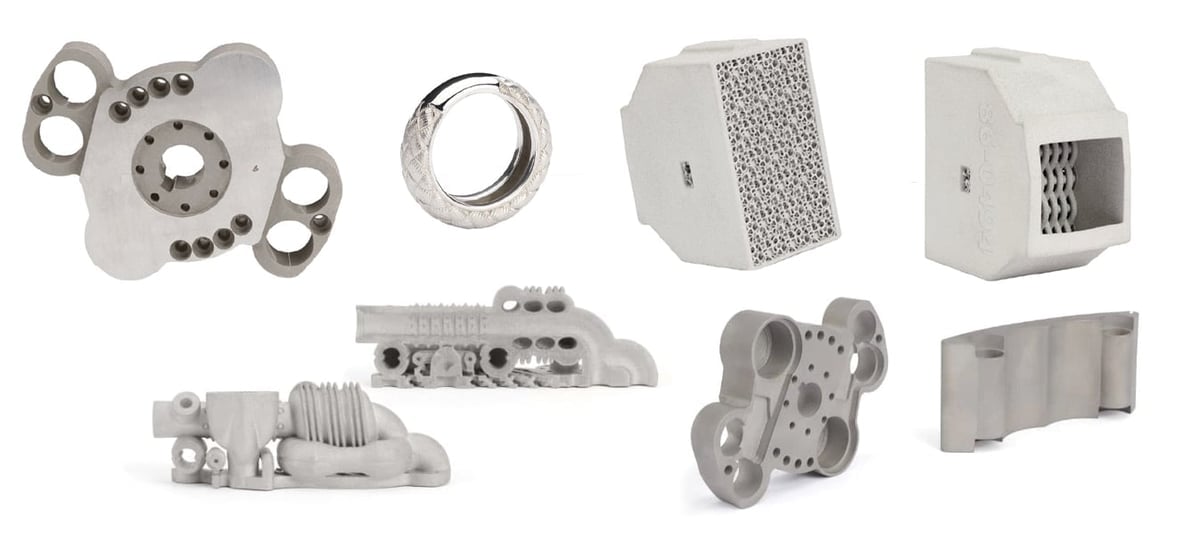
HP S100 Metal Part Production as a Service
For many manufacturers interested in the type of part complexity metal 3D printing can offer, this amount of equipment may not be ideal. Alternatively, there’s a growing number of 3D printing contract manufacturers. HP offers metal parts production-as-a-service through (currently) two manufacturing companies; GNK Additive and the above-mentioned Parmatech.
“We are working with other partners that haven’t been disclosed,” says Meaghan Ferris, HP’s global head of G2M and business development for 3D metals. “Now that the solution is commercially available, we will also ramp up with new partners looking to offer more advanced, digital metals manufacturing with HP Metal Jet.”
The full HP Metal Jet S100 Printing Solution is expected to be widely available sometime in the first half of 2023.
License: The text of "Is HP Now Revolutionizing Metal 3D Printing, Too?" by All3DP Pro is licensed under a Creative Commons Attribution 4.0 International License.
